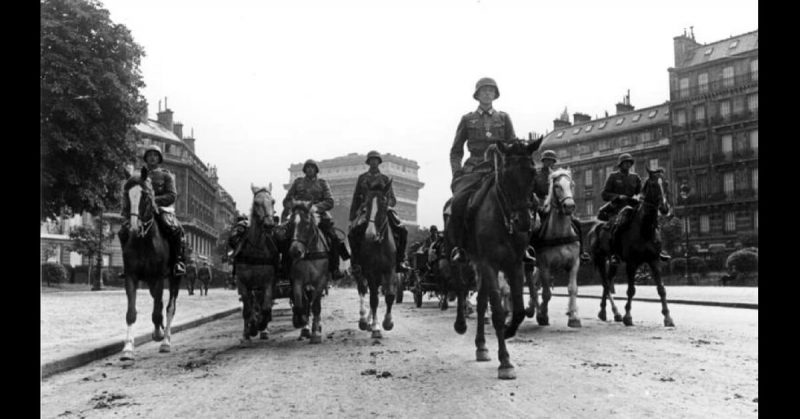In late 1944, a man sat in a French café wearing a long, dark cape. Around him were German officers grumbling and cursing President Roosevelt, the Marine Corps, and local French resistance forces.
The grumbling suddenly stopped. The man had opened his cape to reveal a US Marine uniform, and a .45 caliber pistol in his hand. Having gotten their attention, he ordered them to drink a toast to the American president. Having no choice, they did.
He then ordered them to make another toast. This time to the Marine Corps, so they did. Then with a gallant bow and a massive grin, he disappeared off into the night.
Pierre Julien “Peter” Ortiz was born on July 5, 1913, in New York City to a Swiss-American mother and a French-Spanish father. Later his parents divorced, and he was sent to the University of Grenoble in France to be educated.
In 1932 at the age of 19, he joined the French Foreign Legion. He was sent for training to Algeria with the 1st REI which he passed with flying colors. His next stop was Morocco where he was assigned to the 3rd Machine Gun Company of the 2nd REI in June 1933. He became a corporal and then a sergeant two years later.
For his services, he was awarded the Croix de Guerre twice and also received the Médaille Militaire. Impressing his superiors, he was offered a commission and French citizenship. Instead in 1937, he returned to the US where he became a military consultant for Hollywood.
With the invasion of France by Germany in 1939, he tried to get back to Europe to rejoin the Legion, but a German U-boat sank his ship. Fortunately, he was rescued by a French liner, enabling him to re-enlist on November 6.
Ortiz took part in the Battle of France in 1940 where he was injured blowing up a fuel depot. The Germans took him prisoner, but he escaped and made his way back to the US the following year. Then came Pearl Harbor and the US joined the war.
The Office of Strategic Services (precursor to the CIA) wanted to recruit him. They took too long, however, so Ortiz enlisted with the US Marine Corps in June 1942. Due to his previous experience and the fact he spoke ten languages, including German and Arabic, he was commissioned as a second lieutenant after only 40 days service. He was then promoted to captain.
Ortiz was assigned to North Africa where he used his connections to gather intelligence on the Axis forces.
In early 1943 he became a member of the OSS and was involved in the action at the Battle of Kasserine Pass. Shot in his right hand by a German patrol he retaliated by using his other hand to blow up their jeep with a grenade. He was sent back to the US for repairs.
In 1943, the Allies were preparing for Operation Overlord – the invasion of France’s Normandy Beaches. Ortiz and two others volunteered for Operation Union (also called the Jedburgh Program) – the training and equipping of the French resistance.
The trio parachuted into the Rhône-Alpes region on January 6, 1944. Ortiz pretended to be an effeminate Parisian fashion designer looking for work. He and his team sabotaged German garrisons, ambushed patrols, and destroyed rail lines – all while wearing their uniforms.
The Germans and Vichy-French launched a major manhunt, increasing the reward for their capture. In May they were pulled out. Ortiz was promoted to major and decorated with a Navy Cross.
On August 1, 1944, Ortiz, a US Army captain, five Marines, and a Free French officer parachuted into Col des Saisies in the French Alps – Operation Union II. It did not go well. One Marine died on the way down, another was severely injured and had to be pulled out, while the Germans were hot on their heels.
Not that it stopped them from making life miserable for the Germans – especially as they had lots of equipment. To increase morale among the locals, the six men went around in their Marine uniforms – even the Free French officer who was not a Marine.
It was during this period that Ortiz made his way into a French café filled with grumbling German officers of the 157th Division. In a later interview, Ortiz stated he did not shoot any of the officers because he wanted to spare the village from reprisals.
On August 16, as they were passing through the town of Centron they were attacked by a German convoy. Fighting erupted, but they were surrounded. Ortiz offered to surrender his “entire garrison” if the villagers were spared.
Ortiz was sent to a POW camp. In April 1945, he and three others escaped, shortly before it was liberated later that month.
Back in the US, he offered to fight in the Pacific, but Japan surrendered in August.
With the war at an end, he remained in America. Ortiz was the most highly decorated member of the OSS. His medals include two Purple Hearts and the Order of the British Empire among others.
He settled down advising Hollywood about war. He also did some acting work. He was not very good, but then no one is perfect.
